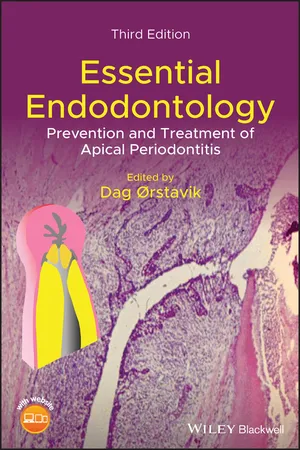
Essential Endodontology
Prevention and Treatment of Apical Periodontitis
Dag Orstavik, Dag Orstavik
- English
- ePUB (mobile friendly)
- Available on iOS & Android
Essential Endodontology
Prevention and Treatment of Apical Periodontitis
Dag Orstavik, Dag Orstavik
About This Book
The authoritative reference that continues to present a systematic analysis of the scientific basis of endodontology
The third edition of Essential Endodontology: Prevention and Treatment of Apical Periodontitis has been revised and updated to include the most recent developments in the field, maintaining its position as the major scientific treatise of apical periodontitis. Making an often-complex subject more digestible, the book explores the scientific basis of endodontology, adopting a systematic analysis of the available clinical and laboratory evidence.
Promoting apical periodontitis as a disease entity, the comprehensive third edition focuses on its biology and clinical features, enabling the reader to have a better understanding of its diagnosis, prevention and treatment. In addition to thorough updates and full colour illustrations throughout, a new chapter on regenerative endodontics has been added to this edition.
- Written with a focus on the scientific basis of endodontology
- Includes a new chapter on regenerative endodontics
- Presents the most current information and major developments in this fast-moving field
- Provides helpful learning outcomes in each chapter
- Contains full colour illustrations, enriching the text
- Features contributions from a noted panel of international experts, including new contributors from across the globe
Regarded as a vital companion to the pursuit of excellence in postgraduate and specialist education, Essential Endodontology is an indispensable and accessible resource for practicing endodontists, postgraduate students of endodontology and those seeking professional certification in endodontology.
Frequently asked questions
Information
1
Apical Periodontitis: Microbial Infection and Host Responses
1.1 Introduction
1.2 Terminology

| AAE | ICD‐10 |
| Symptomatic apical periodontitis SAP1 | K04.4 Acute apical periodontitis of pulpal origin2 |
| Asymptomatic apical periodontitis AAP | K04.5 Chronic apical periodontitis |
| Chronic apical abscess | K04.6 Periapical abscess with sinus3 |
| Acute apical abscess | K04.7 Periapical abscess without sinus |
| Condensing osteitis4 | |
| Radicular cyst | K04.8 Radicular cyst |
Table of contents
- Cover
- Table of Contents
- Foreword
- List of Contributors
- About the Companion Website
- 1 Apical Periodontitis
- 2 Dentin‐Pulp and Periodontal Anatomy and Physiology
- 3 Etiology and Pathogenesis of Pulpitis and Apical Periodontitis
- 4 Microbiology of Apical Periodontitis
- 5 Epidemiology, Treatment Outcome, and Risk Factors for Apical Periodontitis
- 6 Radiology of Apical Periodontitis
- 7 Clinical Manifestations and Diagnosis
- 8 Biological Basis for Endodontic Repair and Regeneration
- 9 Prevention
- 10 Vital Pulp Extirpation
- 11 Endodontic Treatment of Apical Periodontitis
- 12 Surgical Endodontics
- Index
- End User License Agreement